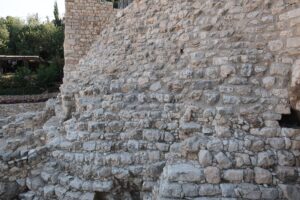
Stepped Structure Unearthed in the City of David. By Davidbena – Own work, CC BY-SA 4.0, https://commons.wikimedia.org/w/index.php?curid=108076374
Unique monumental structure inside Israelite Jerusalem defies explanation
There it was in the headline on page one of what is supposedly the most reliable and accurate newspaper in the country, the prestigious New York Times– “Palace of David or Solomon Believed Found.” The headline writer cannot be faulted, for he accurately reflected reporter Michael Widlanski’s lead- “Israeli archaeologists have unearthed what they believe was probably the palace-fortress of King David or King Solomon,” the story began. This inaccurate lead was then picked up and repeated in dozens of newspapers through out the country.
Yigal Shiloh, the Hebrew University archaeologist who directs excavations in the oldest inhabited part of Jerusalem (an area known as the City of David) had surely made a discovery of front-rank importance in the unusual and monumental stepped structure which the New York Times falsely represented as a palace-fortress. But the more than 50-foot-high structure found near the crest of the dusty spur on which the 11-acre City of David is located is probably not even a building.
The top half of the stepped-structure has long been known. (The picture of the eastern slope in the previous article shows the stepped-structure before the 1980 excavations when only the upper courses were exposed.) It was first uncovered by Irish archaeologist R. A. S. Macalister who excavated in this area between 1923 and 1925.
Read the rest of New York Times Misrepresents Major Jerusalem Discovery in the online Biblical Archaeology Society Library.